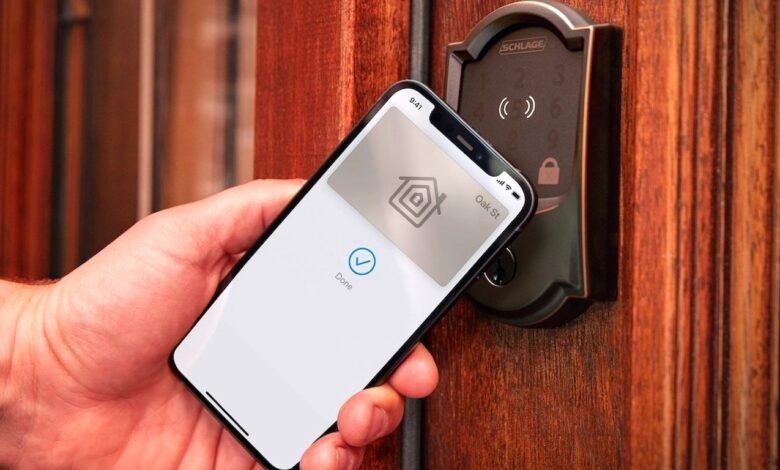Apple HomeKit: 7 Top Features You Should Try

For good reason, Apple HomeKit is one of the most widely used smart home systems. In a smart home where Apple products are commonly used, it provides an extensive range of functions to utilise. These are a few of the top features that you need to use.
1. Apple Home Key
As long as your lock is compatible with the feature, Apple Home Key improves on a smart lock (don’t worry, it’s well worth the entry price).
The lock itself, together with an iPhone and an Apple Watch, is equipped with NFC technology. Your iPhone or Apple Watch securely store a digital key. Using the Home app, you may set up two distinct options for when you wish to lock or open a door.
At the start, to lock or unlock the door, simply tap the watch or handset in Express Mode. After pressing the device close to the lock, you can optionally opt to authenticate using Touch ID or Face ID on your phone for additional protection. Moreover, you can lock or unlock your smartphone by using the Home app.
It’s easy and incredibly useful to be able to unlock the front door while carrying a bunch of goods. You’ll want a compatible smart lock on every door after using it.
HomeKit Secure Video
One of the best applications of smart home technology is home security. One interesting product that connects several ecosystem components is Apple’s HomeKit Secure Video.
It works with both compatible home security cameras and video doorbells. All recordings made with HomeKit Secure Video are kept in your current iCloud+ storage and are secured from beginning to end. With the appropriate tier, videos don’t count against storage restrictions (the more you pay, the more cameras you may connect).
Using your current Photo Library and a special face recognition feature, you can even use notifications to display the person’s name. Along with detecting people and parcels, this capability can also overlay notifications in the form of pictures on top of whatever you’re seeing.
Adaptive Lighting
Another user-friendly feature of connected HomeKit lighting is adaptive lighting. As the name implies, it will adjust the lighting automatically throughout the day to better match the natural light outside and your circadian cycle.
The lights will have a warmer, more yellow tone in the morning. By lunchtime, it will become colder, and by night, the colours will become warmer. All of the adjustments take place automatically after the setup process is finished.
Related: Future Apple Watches Might Include Cameras
Temperature-Activated Automation
One excellent way to make the most of a smart house is through automation. Utilising temperature-based automation is a pleasant way to get the most out of HomeKit. Several gadgets have humidity and temperature sensors, including the HomePod small and second-generation HomePod. The Home app provides access to that data.
Thus, you can develop a temperature-based automation system with minimal effort. For instance, you can arrange for a fan to turn on automatically in your bedroom if the temperature goes above a particular level. The fan can be turned off after the temperature returns to normal. The data can be used in a plethora of additional ways to build an effective smart home.
Sound Recognition
There’s more to a HomePod or HomePod mini than just using Siri to manage smart home appliances or play music. The smart speaker is always listening for the sound of a smoke or carbon monoxide alarm when Sound Recognition is turned on. When you’re not at home, your iPhone and Apple Watch will receive an alert if that sound is detected.
To check in and maybe have a conversation with anyone who is at home using the HomePod, you can tap the alert. The HomePod’s screen will display the live feed from any HomeKit cameras that are in the same room. When you’re away from home, it can be unsettling to think about a fire or carbon monoxide alarm, but sound recognition can make you more prepared in an emergency.
Intercom
Use the intercom feature to announce that dinner is ready instead of screaming it over your entire house. You can use Intercom to send and receive voice messages from another Apple device to your HomePod or HomePod mini.
Say “Siri, Intercom” to communicate with every HomePod and gadget in your house. Additionally, you can message a HomePod that is situated in a certain area of your house. It is also possible for anyone who hears the message to reply.
Related: The Best Apple Products of 2023
Share HomeKit Control With Others
While utilising smart home technology alone is excellent, what happens to family members or even guests who want to unlock a door, turn on the lights, or complete other tasks? Thank goodness, Apple considered that. You may allow someone to operate your smart home with ease using the Home app, provided they own an iPhone, iPad, or Mac.
Removing permission is simple, and you have additional discretion over how much authority you grant to other people. You can decide whether the other person can add and remove automations, scenes, and accessories, and whether they can control them from anywhere as long as they are connected to the home network.
TakeAways
For those who enjoy smart homes, Apple HomeKit has plenty of fantastic features. Here are some fantastic smart home automations that lighten your daily load and maximise the potential of HomeKit—or any other platform.











